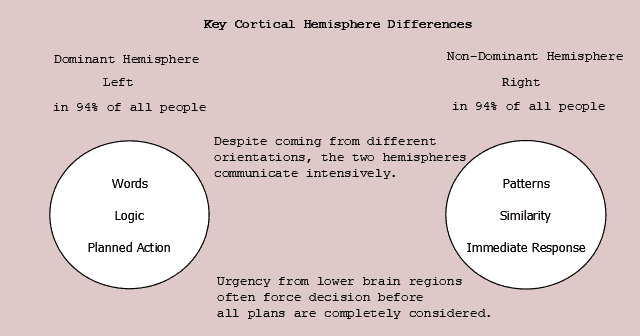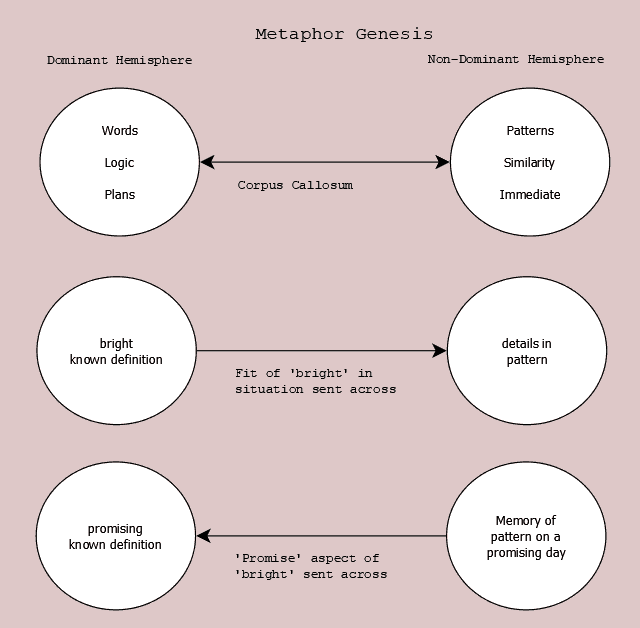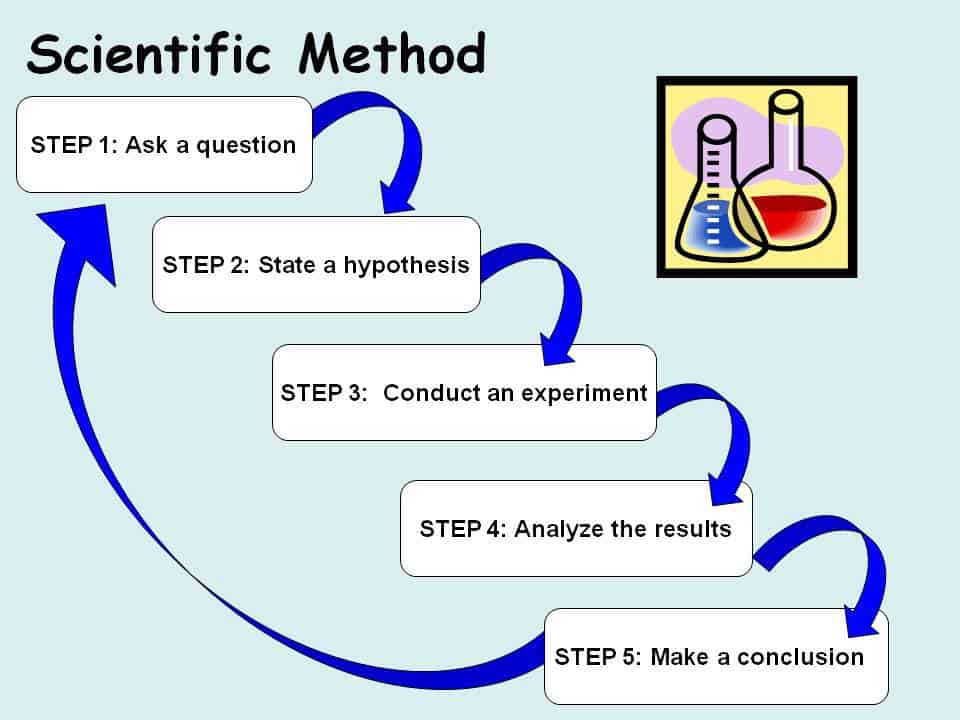The Mental Construction model of cognition melds the triune mind with the rational layer a dual process cap. To set the stage, let’s discuss the triune then the dual process model of thinking (Figure 23.1).
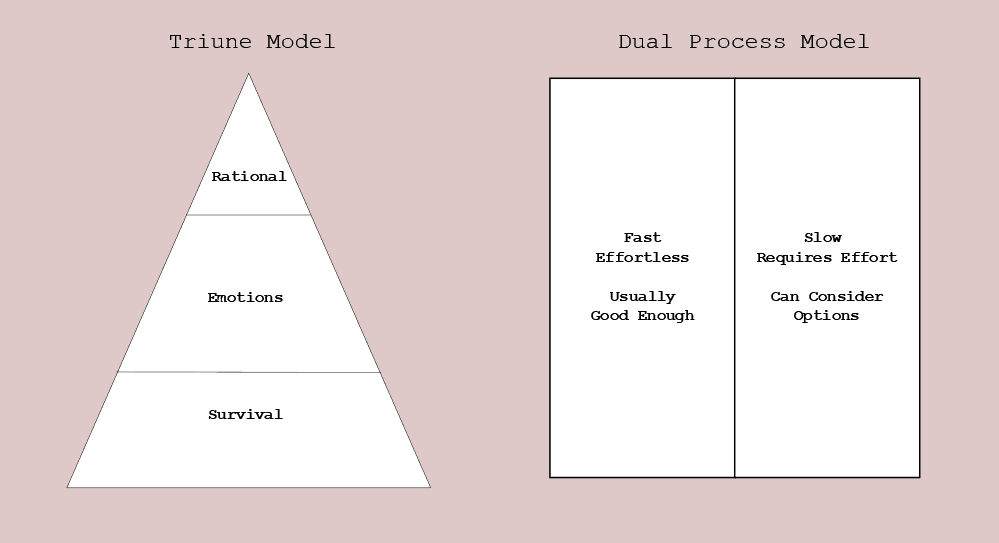
The triune brain model (left side of Figure 23.1) segments decision-making into three layers.
- The reptilian brain (brainstem and basal ganglia) at the base. Focus: survival of the physical organism.
- The paleomammalian brain (limbic system) above the base. Focus: immediate satisfaction of reptilian demands, felt as emotional reactions.
- The neomammalian cap (neocortex) where conscious decision-making comes is made. Focus: consider future possibilities as well as immediate responses.
The reptilian layer assesses the current situation according to its guiding principles, the 3S Imperatives. Each imperative involves a binary choice. If the choice is act, the act is immediate.
Then our paleomammalian layer (limbic structures) receives the reptilian status (act or not immediate act demanded). It merges together that status with its memory of similar experiences and their outcomes. The possible satisfaction of the 3S Imperatives, each partially satisfied by any response, is merged in the limbic layer as an emotion.
Finally the neomammalian cap (neocortex) enhances further the preliminary sensory analysis of the reptilian and limbic system, allowing consideration of additional behavioral options, which involves a dual process capability.
The dual process model (right side of Figure 23.1) focuses on reasoning that occurs in two ways.
- Fast, automatic, and unconscious behavioral choices. No effort is required to think things through.
- Slow and requiring effort while allowing many choices to be considered.
The first Dual Process mode—Fast—merges together organism safety and emotional reactions with cognition in the highly evolved prefrontal lobes of the non-dominant hemisphere, which is non-verbal. The second Dual Process mode—Slow—focuses closely on verbal, logical, and deductive, which ignores the considerable neural power of the non-verbal hemisphere to extract patterns from situations and experiences.
Mental Construction Model (Figure 23.2) uses the 3S Imperatives (Satiety, Sex, Safety—organism demands) to develop needs, desires, and fears (emotions) which in turn can be satisfied through either the fast, inductive process or the slower, deductive process which share the highest level of cognition.
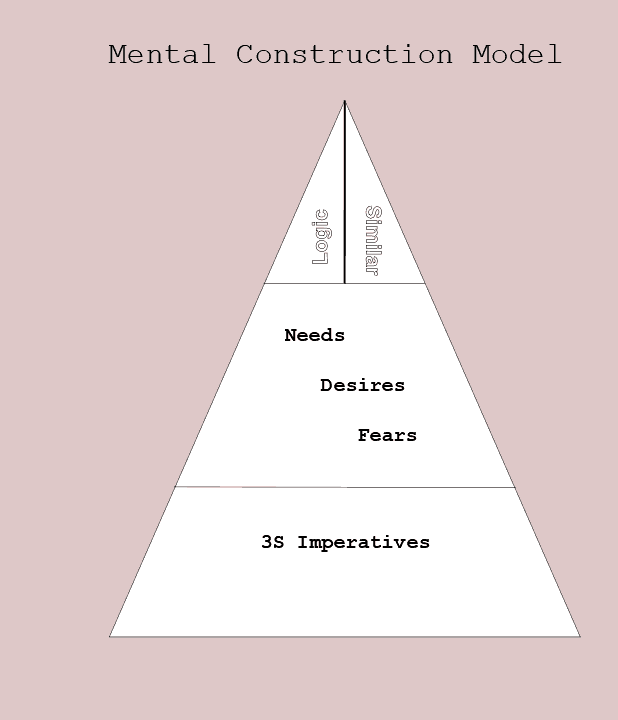
With induction (similarity, patterns) and deduction (logic) occurring in parallel, you might wonder about the potential for chaos and conflict in decision-making. Although that does happen occasionally, the brain’s operation is as smooth as it is because our decision-making functions on two different time frames.
- Immediate demands are satisfied by inductive answers, based on our current reality. Decisions are required at once. As General George Patton remarked, “A good decision today is better than a perfect decision tomorrow.” Still in the military mindset, good decisions can lead to collateral damage—undesired side effects often occur with inductive reasoning.
- When the 3S imperatives do not demand immediate action, achieving long-term goals and avoiding problems are best handed by deductive reasoning. Deduction, which uses verbal categorization, can consider prospective changes that our behavior can make to our reality.
I am not asserting that decision-making is perfect. Under stress, good logical options under consideration can be tossed aside as satisfy an immediate demand. In other cases, significant internal conflict can be experienced when a long-term goal means immediate satisfaction must be given up.
Demands on the Brain
We have immediate demands and we have long-term demands. Make it through the moment and, only after that’s assured, do we look to improve our situation.
Induction is non-verbal reasoning based on similarities, patterns, and associations. It is fast, requiring minimal effort; unfortunately along with those benefits, this also introduces the possibility of error, associating ideas which can overlook important distinctions.
Deduction is word-based reasoning based on logic. It requires effort and is constrained by the limited size of working memory. Deduction’s great benefit is that allows complicated calculations with its conclusions guaranteed, if its premises are true.
Mental Construction proposes a hierarchical model of decision-making(Figure 23.3). The 3S imperatives (Satiety, Sex, and Safety) are to be appeased through their psychological manifestations as needs, desires, and fears through choices prepared simultaneously by our two cortical hemispheres. The non-verbal frontal lobe focuses on the immediate physical situation, while the dominant hemisphere (the hemisphere generating and decoding speech) considers possibilities suggested by logical consideration of the word-labelled characteristics.
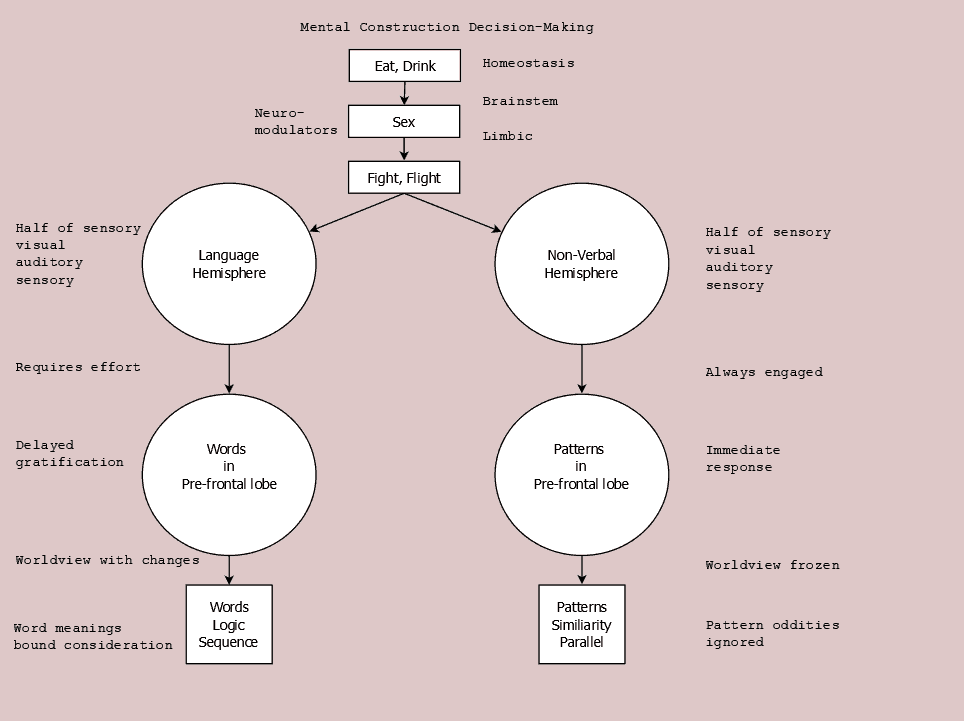
Cortical Hemisphere Interaction
Words and patterns are preferentially processed in separate hemispheres, but they are not isolated. They shuttle across to the other side, words enforcing categories onto information and patterns relating associations.
The hemisphere with primary verbal tasks is called the dominant hemisphere. This chart of handedness (Figure 23.4) summarized the statistical relationship between right hand dominance and the hemisphere controlling speech. Of the 90% of all people who are right handed, 98% of them have the left hemisphere dominant for speech. So speech and bodily dominance both reside in the left hemisphere for 88% of all people (90% * 98% = 88.2%).
The second row shows that 10% of all people are left handed or ambidextrous. Of that 10%, more than half (60-65%) use their left hemisphere implying that 35-40% use their right hemisphere for both speech and physical action by their preferred hand. That accounts for another 3.5-4% of people who use the same hemisphere for speech and hand.
About 92% (88.2+3.5 = 91.7; 88.2+4=92.2) of people use the same hemisphere. The other 8% have additional shuttling of their verbal decisions to physical actions across the cortical divide.
The synchronization of speech and handedness across the hemispheres is not all the coordination that is performed.
Despite functional separation within the cortical hemispheres, the hemispheres communicate across the corpus callosum. Although the nondominant side processes data by its own metric—association—at this point the focus is how the words of the dominant hemisphere interact and are enhanced by communication with the nondominant.
Synchronization of Cognitive Processes
In the top of Figure 23.5, key differences between the cortical hemispheres are noted. The dominant hemisphere uses words to label, categorize, and logically manipulate its internal view of reality. Using words allows deductions and planning to meet one’s goals, present and future. These verbal techniques, performed by specialized neural networks, take time and effort.
The non-dominant hemisphere processes new data as patterns, rather than categories which are verbal, linguistic categories. Patterns include sensory arrangements including sequencing by sequence and prior conjunction. Although abstraction always takes place at Almost Gates, that loss of pattern detail is less than when a word is substituted for the diversity of a phenomenon.
Although often casually discussed as distinct, the hemispheres are not divorced from each other, except in rare cases when they are surgically severed. Abstractions (words and patterns) are shared across the corpus callosum, allowing the best of categorization and association to be weighed before action must be taken.
Words Come into Play
Sensory processing initially quite similar paths in the cortical hemispheres. It’s not until words are assigned to phenomena that differential categorization takes place. About 94% of the time, this categorization takes place in the left hemisphere. Once the phenomenon has a word handle, the word becomes a unit of mentalese. Power is gained because logical consequences can be deduced from verbal propositions; however, details are shed when a word replaces a phenomenon.
The literal meanings of the words active shape the dominant hemisphere’s reality, which is composed of facts as well as explanations and predictions.
Corpus Callosum
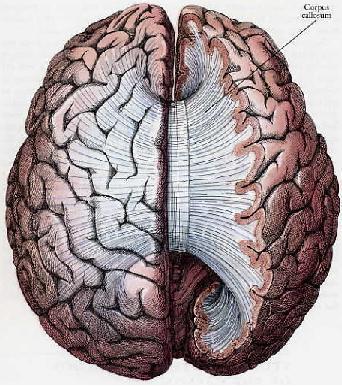
The brain is viewed from above in Figure 23.6. On the right side, an inch or so of the top cortical layer has been removed. The front of the brain is at the top of the image.
Exposed is the band of the corpus callosum, 200 million axons connecting the two sides of the brain’s cortex. The primary function of the corpus callosum is to integrate motor, sensory, and cognitive performances between the cerebral cortex on one side of the brain to the same region on the other side.
With 200 million axons linking together 15–20 billion cortical neurons, there is a communication between every 75–100 neural activity steps. That is, as sensory input is processed for delivery to the prefrontal lobe and then a decision communicated back to initiate behavioral activity.
Patterns between the two hemispheres are exchanged all the way from shortly after initial sensory receipt up through the multiple stages of integrating the various sensory modes together to merge with memory and worldview. Along the way, the dominant hemisphere assigns words to the information.
Once words are attached, the left side’s communication across the corpus callosum is the word, a defined collection of features.
Across the Corpus Callosum
Nondominant Hemisphere
The right side retains a fuller representation of the phenomenon. Particular details remain longer with the original, particular data.
- When the right hemisphere receives the word (a convention set of features) across the corpus callosum, the receipt triggers a neural process.
- This process runs the word through the existing phenomenon context.
- Case 1. Both the word and the pattern surmount the existing phenomenon context’s Almost Gate, the pattern is returned to the dominant hemisphere.
- Case 2. The word surmounts the Almost Gate and the pattern does not. The pattern is replaced by the word and continues in the nondominant hemisphere as a pattern (i.e. losing associations with other words).
- Case 3. The pattern surmounts the Almost Gate and the word does not, the pattern continues.
- Case 4. Neither word nor pattern surmounts the Almost Gate for the existing context, the original pattern continues.
Dominant Hemisphere
- The dominant hemisphere receives the nondominant’s active pattern. A neural process is triggered, comparing the result of the pattern with that of the word.
- Analogous cases 1–4 exist, with the role of word and pattern reversed.
Metaphors
On a macroscopic level, metaphors are a good example of this operation Figure 23.7 is a gloss of the metaphorical action that can occur when the dominant hemisphere assigns the category “bright.” The right hemisphere
Let’s consider a simple synchronization first.
- The left assigns the word “bright” to a summer day.
- The right hemisphere doesn’t dispute that, but it may amplify the memory of bright because another summer day had something particularly good associated with it.
- The left, receiving that information across the corpus callosum, changes its description to “promising.” That’s a figurative change from the nondominant hemisphere that adds meaning.
Synchronization is attempted from our most immediate sensation to our most advanced conceptions. Also, see left-right brain discussion which discusses the common overstatements about the hemispheres.
Immediate Response
An excellent example of our need to handle immediate worldview is playing sports. When we really get physically involved in a sport, our internal monologue, the voice of our left hemisphere, can be totally silenced.
When an immediate response is required, induction yielding results by ignoring distinctions and substituting close similarities gives faster answers, which usually are fine.
Planning for Later Success
Deduction allows consideration of alternative future worldviews. It can search for those which satisfy more of our needs and desires goals and squelches our fears, all predicated on our 3S imperatives. Verbal processing, checking for logical links between disparate concepts, requires us to focus our attention, but there remains the constraint of limited working memory. Logical analysis is fatiguing and requires inattention to much immediate sensations.
Induction and Deduction Together
Why ever consciously choose induction, which might lead to a false conclusion, when deduction always leads to a valid conclusion? Simply because we rarely have enough perfect information to compose an iron-clad deductive argument.
Stanovich (p 63) discusses cognitive misers, arising from the observation that most people will take the easiest means to obtain answers at all times, even when more deliberate analysis can lead to a better response.The tendency to be cognitive misers is the tendency to rely on induction and similarity for ordinary thought.
In Thinking Fast and Slow, Daniel Kahneman (p 32) mentions Hess … had noticed that the pupils are sensitive indicators of mental effort – they dilate substantially when people multiple two-digit numbers and they dilate more if the problems are hard than if they are easy.Deduction requires firm facts on which to reason. These facts are coded in words and fixed relationships.
The important question of the neuro-biological process which causes the switch-over from immediate response to delayed gratification is not addressed by them. Both Stanovich and Kahneman assume it occurs and proceed from that recognition.
It’s likely that some combination of the neural threshold leading to the action choice prompts neuromodulators, like norepinephrine and dopamine (Spitzer p 272), sharpens the contrast between the selected action path and alternative action paths.That mechanism is yet to be dissected.
A deliberate mechanism for uniting the powers of induction and deduction and to overcome their respective weaknesses is displayed in the scientific method.
Scientific Method
Scientific knowledge grows by using the scientific method (Figure 23.8), an intelligent combination of induction and deduction.
The origin of the scientific hypothesis is creative, not logical. Hypotheses arise from metaphorical thinking, noticing similarities and ignoring differences. The Encyclopedia Britannica writes,
The generation of a hypothesis frequently is described as a creative process and is based on existing scientific knowledge, intuition, or experience.
At the start, there is insufficient data to prove or disprove the hypothesis. Experiments are performed based on the hypothesis in conjunction with the accepted scientific background theory.
Results in hand, the scientist logically compares the result to the prediction, deducing a conclusion.
The hypothesis is either strengthened by a consistency between forecast and result or it is rejected if the results are contrary to the forecast.
In this manner, induction and deduction are used in tandem to grow scientific knowledge.
Creativity, A Few Scientific Examples Kepler, Mendeleev, Dirac
Summary
Using a similar, hypothetical approach to daily life, we can grow our understanding of our world. Of course this requires us to give up ideas that are disproven by events. Unfortunately most of us make each hypothesis a part of our personality. When a result contradicts a part of our worldview, instead of revising the hypothesis, we reject the fact by adding conditions to its occurrence which explains the anomaly.
Despite the difficulty of treating our internal worldview as a theory or an hypothesis, the scientific method applied our worldview is the best way to logical derive the consequences of our induction creations and remain tied to the external reality our lives are experienced in.
Everything together leads to this Decision-Making Model.

